- Home
- Sue Grafton
V is for Vengeance Page 21
V is for Vengeance Read online
Page 21
In the absence of an intercom, Dante hollered for his secretary in the outer office. “Bernice? Could you come in here please?”
“In a minute. I got stuff to finish first.”
Dante shook his head. The girl was nineteen. He’d hired her four months before and she already had his number. He sorted through the papers on his desk until Bernice appeared in the door. She was tall and lanky with a big wad of frizzy blond hair she wore in a ponytail. She came to work in jeans and running shoes, which was fine with him. The low-cut top he could have done without. Weren’t women these days taught anything about modesty?
“What?” she said.
“You know my brother?”
“I look like an idiot? Everybody knows Cappi. He’s crazy as a loon.”
“I’d like you to keep an eye on him. He’s new to the concept of work for pay. I don’t think he’s got the hang of it yet.”
“I charge extra to babysit,” she said.
“How about spying?”
That idea seemed more appealing to her. “You want regular reports?”
“That would be nice,” he said. “Meanwhile, get Dade O’Hagan on the line. His number’s in there.” He pushed the Rolodex in her direction and watched as she worked her way through.
“O’Hagan, like the mayor?”
“Ex-mayor. You’re behind the times. This is old business. I’m calling in a marker if it’s any of your concern.”
She smiled. “Hot stuff.”
“You bet.”
15
I left Marvin’s house at 2:15 with a promise to keep him posted on my progress. I was feeling more optimistic. Marvin’s mention of time travel had sparked a train of thought. I too had regretted I couldn’t go back to relive those moments in the parking garage when I’d blown the opportunity to pick up the plate number on the black sedan. The nice man who’d come to my aid had suggested I notify mall security and file a report. At the time, I’d been distracted by my outrage, my throbbing shin, and my badly scraped palm. With Marvin’s offhand remark, it dawned on me that I did have a way to go back in time and review events. I knew the woman in charge of mall security.
Maria Gutierrez had been the beat officer assigned to my neighborhood some six years before. On the last case I’d worked, I’d crossed paths with her former partner, Gerald Pettigrew, who was now in charge of the K-9 unit at the Santa Teresa Police Department. Maria’s name hadn’t come up in conversation, but she’d been on my mind. Some months before, I’d found myself standing behind her in the checkout line at the supermarket. She looked familiar, but she wasn’t in uniform and I didn’t make the connection. She’d been quicker at the recognition. She greeted me by name and identified herself. As we inched our way closer to the register, we played a quick game of catch-up. I filled her in on my life, Henry’s whereabouts, and my last encounter with Lieutenant Dolan, whom she knew from the police department. She told me she’d resigned from the PD in order to take a job in the private sector. That’s when she’d given me her business card.
I stopped by my office and sorted through the pile of business cards I routinely toss in my bottom drawer. After a bit of digging I found hers, and I was just about to call when I noticed the light blinking on my answering machine. I punched play.
“Hello, Kinsey. This is Diana Alvarez. Please don’t hang up. I need to talk to you about the article I’m writing. I’m offering you the opportunity to clarify the facts and add any comments you might have. Otherwise, it’s going in as is. My number is …”
I didn’t bother to make a note.
I checked the phone number on Maria’s business card and called her instead. I told her what had occurred and asked if I could have a look at security tapes for April 22. I thought she might be wary. Security measures are considered proprietary and, therefore, not to be disseminated to the general public. Information leaks are more likely to serve the criminal element than the law-abiding citizen, so it’s better for all of us if crooks are kept in the dark about how the traps are set. Apparently, the fact that I was a PI and already known to her constituted a waiver. I gave her my guarantee that the information would remain confidential. She said she had a meeting at 3:00, but if I could make it to her office before then, she’d be happy to help. Two minutes later, I was in my car and on my way. Screw Diana Alvarez.
I found a parking spot at the Nordstrom’s end of the underground structure at Passages Shopping Plaza. I bypassed the escalator and took the stairs up a level, where the retail storefronts had been designed to resemble an old Spanish town. The narrow shoulder-to-shoulder buildings varied in height. Most were stucco with the occasional picturesque chunk of plaster missing to expose the faux brick underneath. Some boasted pricey second-and third-floor offices, with shutters at the windows and flower boxes on the sills.
Along the wide central plaza corridor there were boutique restaurants with outdoor tables, benches for weary shoppers, and kiosks selling sunglasses, junk jewelry, and women’s hairpieces. At the midpoint, a stage had been constructed where musicians played for summer tourists. I went up a wide set of red-tiled stairs to the second floor. To my right there was an auditorium available to local theater groups for stage productions. The mall business offices were located down a hall to the left.
Maria was waiting at the desk when I walked in.
“You’re a doll to do this,” I said.
“No problem. The police circulated the information to all the store managers and cc’d us so we’d know what was going on. Included with the bulletin was Audrey Vance’s mug shot.”
“Did you recognize her?”
“Not me, but I heard a salesgirl at Victoria’s Secret saw her the same day. Apparently, she’s a regular customer and nobody had any idea she was stealing from them. They’re doing an inventory check now to see how badly they were hit.”
“I thought these gangs originated in South America.”
“Those are the worst. They can sweep through and clear a tabletop in the blink of an eye. They blast into town and they’re gone again just that quick.”
“How does it work? They have to be highly organized, but I don’t understand how they operate.”
“You start with the worker bees, who go out and steal the merchandise. Sometimes they’re given a regular shopping list, products the fence knows he can sell. For instance, there’s a big traffic in Gillette razor blades, Tylenol, Excedrin, pregnancy tests, diabetic test strips. I’ve heard Oil of Olay products are a hot ticket as well. The list goes on and on and changes all the time.”
“You mentioned Victoria’s Secret.”
“Sure. Think how many bras you can fit in a shopping bag. Same with panty hose. It’s much tougher to steal bulky items like men’s cologne sets or VCRs. You can’t jam a TV down the front of your pants.”
“But where does the fence lay off the goods?”
“Swap meets are a good bet, thrift stores—places like that. A lot is shipped out of the country.”
“Are these rings run by the mob?”
“Not in the old-fashioned sense of the word. If the business was mob-run, you’d have a widespread network that might be vulnerable to infiltration. These crews are connected loosely, if they’re connected at all, which makes apprehension and prosecution a pain in the butt. In each city, the setup is different, depending on how many people have been brought in and what kind of fencing operation is up and running in any given area.”
“I remember the good old days when I was a rookie, shoplifters were amateurs.”
“Not anymore. We still have the dabblers and wannabes, teenagers sneaking record albums into their backpacks, thinking they can get away with it. Kids are the least of our worries. Though if you ask me, we ought to go after them and nail them.” She waved a hand, impatient with the subject. “Don’t get me started. Come on back and let’s take a look at what we’ve got.”
“You still like the new job?”
“I love it,” she said over her shoulder.
Depending on the angle, I could just about guess where each camera was mounted, though, in truth, I’d never noticed them before. Both entrances and both exits of the parking garage were covered. There were an additional six cameras anchored at the second-floor level, each one focused on a different line of sight. I followed one shopper from the time she entered the mall off State Street until she turned left into the main avenue and disappeared from sight. Another camera picked her up as she proceeded down the wide walk toward Macy’s and went into the store. None of the pedestrians seemed to have any idea they were being watched.
“These work off coaxial cables,” Maria said. “All of the cameras operate at the same time. By swapping out cassettes, we can capture images twenty-four hours a day over the course of a month. Unless we have reason to keep a cassette, we tape over what we’ve done. Eventually the tapes get worn or the CCTV heads get dirty, and the images end up fuzzy and not much use. After I talked to you, I pulled the cassette from last Friday.”
She turned to her desk and picked up four cassettes. “There’s a VCR next door.”
We went into the next office, which was plainly furnished and looked like it was called into service on occasions when a mall executive was in town and needed temporary space. She pulled up a straight chair for me while she took the swivel chair behind the desk and rolled it closer to the set. The VCR was wired to a small black-and-white television that looked like something right out of the 1960s, the screen small and the housing enormous. She checked the date on the first cassette and slid it into the machine. “You said between five thirty and six fifteen?”
“Roughly. It was five twenty-six when I looked at my watch. That’s when I first saw Audrey slide the pj’s into her bag. She was the older of the two women working the lingerie department. By the time the loss-prevention officer was called and the whole scene played out, I’d say it was closer to five forty-five,” I said. “I could be off. Time gets distorted when you’re caught up in these things. At the time, everything went by in a blur and that’s why I missed the plate number. I was so astonished at what happened I didn’t register much else.”
“I know the feeling. On the one hand you’re hyperaware and at the same time you blank out the details.”
“Amen. I couldn’t for the life of me go back and reconstruct the incident.”
“Don’t I know,” she said. “A foot chase you swear took fifteen minutes turns out to be half that. Sometimes it works the other way.”
With a remote, she fast-forwarded. Date and time stamps sailed along in the upper right-hand corner. It was like watching an old-time movie, people walking herky jerky, cars zooming by so quickly they seemed to leave a trail of afterimages. I was amazed at how much the eye could pick up from that fleeting series of pictures. When she reached April 22, she slowed the stream of images to a more stately pace.
I pointed and said, “There.”
Maria hit the pause button and rewound the tape.
The black Mercedes sedan, which was halfway up the ramp, reversed itself and disappeared from sight. She advanced the film by degrees. The car reappeared and I saw the younger woman hand a ticket to the parking attendant, who ran it into her machine. The attendant verified the time stamp, put the ticket to one side, and waved her on. The younger woman looked left and smiled, smug and self-satisfied. That much I remembered. As the sedan continued up the ramp, Maria paused the tape again, freezing the shot of the rear bumper. The license frame was in view but the plate had been removed.
“Now you know why you missed it,” she said.
“What shitty luck. I thought if I picked up the plate number, someone at the PD might run it for me.”
Maria said, “Let’s look at it again.”
She caught the Mercedes on its way up the ramp. It came to a halt with a flick of her remote and disappeared from sight, reversing down the ramp. We watched it as though it were the slow-motion photo finish of a horse race. “Check the license plate frame,” she said. “Top says, ‘Keep honking …’ Bottom says, ‘I’m reloading.’”
She squinted and tilted her head. “What’s that on the right side of the bumper?”
As the car came up the ramp, she stopped the picture midframe. There was a bumper sticker affixed to the right-hand side. I got up and peered more closely, but the picture seemed to dissolve. Both Maria and I backed up halfway across the width of the office space.
She smiled. “That should help.”
“Can you read that?” I asked.
“Sure. You ought to get your eyes checked. Says, ‘My daughter is on the honor roll at Climping Academy.’”
“Oh, wow. That’s great!”
“Right. All you have to do now is find the car.”
“I’ve tackled tougher jobs in my day.”
“I’ll bet. Keep me posted. I want to hear how this turns out.”
Running surveillance is an exercise in ingenuity. As a rule, sitting in a parked car for an extended period generates public uneasiness, especially in a school zone where parents are fretful about abductions, kidnap for ransom, and other forms of child-oriented mischief. Horton Ravine is a natural habitat for wealthy people with expensive tastes. There might be a hundred black Mercedes sedans passing back and forth through the front and rear gates. With roughly eight hundred private homes spread over eighteen hundred acres, my only hope of spotting the car was to find an observation post and wait.
After a quick drive through the area, I decided the obvious location was at the foot of the private drive leading up the hill to Climping Academy. I had to take into consideration that the woman’s bumper sticker might be out of date. Her daughter might have already graduated from Climping. She might have dropped out or transferred to another school. Even if she were currently enrolled, her dad might be in charge of dropoff and pickup, using another vehicle altogether.
Meanwhile, I had to come up with a reasonable explanation for my presence on the road where I intended to keep watch. For short stints, the appearance of car trouble will sometimes work. With the hood up, a puzzled look on my face, and my owner’s manual in hand, I can stall for an hour unless a Good Samaritan comes to my aid. This happens with annoying frequency when I’m least desirous of the help.
Devious creature that I am, an idea occurred to me almost instantly. I left Horton Ravine and took the 101 to a strip mall in Colgate, where I’d seen a large craft mart two doors down from an office-supply store. In the latter, I bought a handheld tally counter, a device that advances one number with each click of a button. At the craft shop, I bought two pieces of heavy-duty poster board, thirty-six inches square, and ten packets of self-adhesive black alphabet letters, with a bonus packet of most-often-used vowels and consonants.
I went home with my packages and set to work on my kitchen counter. With the poster board and stick-on alphabet, I fashioned a sandwich-board sign, hinged at the top, with the same message visible on both the front flap and the back. When I finished the job, I leaned the sign against the wall and climbed the spiral stairs. I sorted through the hanging clothes in my closet and took out my generic uniform, an outfit I’d designed myself and had made many years before. The pants and matching shirt were constructed of a sturdy, no-nonsense dark blue twill, complete with brass buttons, epaulettes, and belt loops through which I can thread a wide black leather belt. On each sleeve I’d sewn a round patch with SANTA TERESA SERVICES embroidered in gold. In the center of the patch there was a vaguely governmental emblem. If I wore clunky black lace-up oxfords and carried a clipboard, I could easily pass for a city or county employee.
I hung the uniform on a peg, ready for my next day’s
work. It was almost 5:00 by then, time, I thought, to check in with Henry back in Michigan. I hadn’t talked to him since Monday, and I felt a twinge of guilt that poor Nell and her broken hip hadn’t even crossed my mind. I sat down at my desk and punched in the Michigan number, mentally composing a summary of what had transpired over the past couple of days. The number rang five times and just when I thought the machine would kick in, Henry’s brother Charlie picked up. “Pitts. This is Charlie. You’ll have to speak up. I’m deaf as a post.”
I raised my voice. “Charlie? This is Kinsey. Out in California.”
“Who?”
“KINSEY. HENRY’S CALIFORNIA NEIGHBOR. IS HE THERE?”
“Who?”
“HENRY.”
“Oh. Hang on.”
I could hear muffled conversation and then Henry took the handset, saying, “This is Henry.”
Once we sorted out who was who, Henry brought me up to speed on Nell’s condition. “She’s fine. She’s tough as nails and never a word of complaint.” He said she’d be in a residential rehab facility for another ten days. They’d come up with a pain-management plan to help her tolerate the physical therapy sessions twice a day. Meanwhile, Henry, Charlie, and Lewis spent the better part of the day with her, playing board games to keep her mind off her infirmity. As soon as she mastered her walker, she’d be allowed to come home. “How’s your shin?” he asked.
I pulled up the leg of my jeans and had a look, as though he could see it as well. “More blue than purple and my palm’s just about healed.”
“Well, that’s good. Everything else okay?”
I filled him in on the latest developments, including Marvin Striker’s hiring me to look into Audrey’s death, my trip to San Luis Obispo, and my theory about her involvement in organized retail crime.

 S Is for Silence
S Is for Silence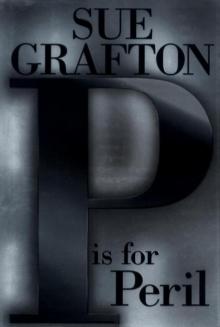 P Is for Peril
P Is for Peril R Is for Ricochet
R Is for Ricochet J Is for Judgment
J Is for Judgment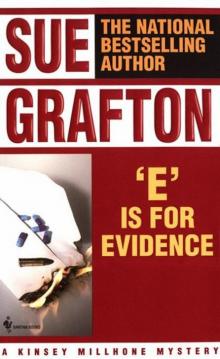 E Is for Evidence
E Is for Evidence T Is for Trespass
T Is for Trespass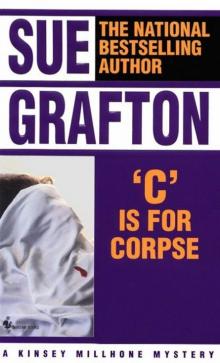 C Is for Corpse
C Is for Corpse U Is for Undertow
U Is for Undertow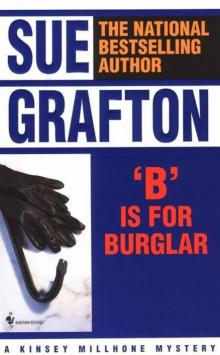 B Is for Burglar
B Is for Burglar Four Sue Grafton Novels
Four Sue Grafton Novels D Is for Deadbeat
D Is for Deadbeat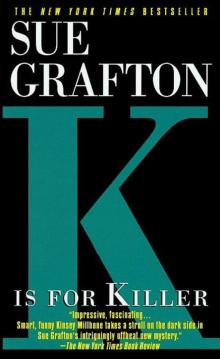 K Is for Killer
K Is for Killer I Is for Innocent
I Is for Innocent A Is for Alibi
A Is for Alibi F Is for Fugitive
F Is for Fugitive Q Is for Quarry
Q Is for Quarry W Is for Wasted
W Is for Wasted Kinsey and Me: Stories
Kinsey and Me: Stories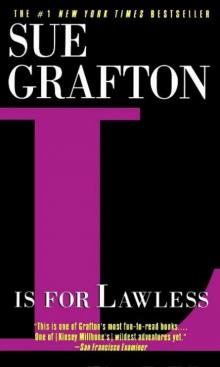 L Is for Lawless
L Is for Lawless Y Is for Yesterday
Y Is for Yesterday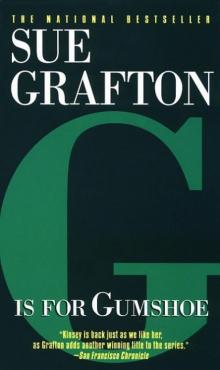 G Is for Gumshoe
G Is for Gumshoe O Is for Outlaw
O Is for Outlaw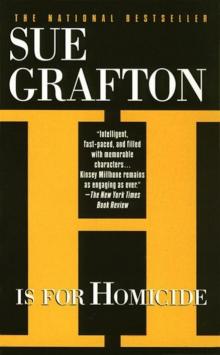 H Is for Homicide
H Is for Homicide X
X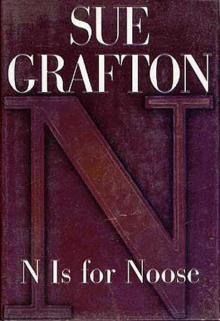 N Is for Noose
N Is for Noose Three Complete Novels: A Is for Alibi / B Is for Burglar / C Is for Corpse
Three Complete Novels: A Is for Alibi / B Is for Burglar / C Is for Corpse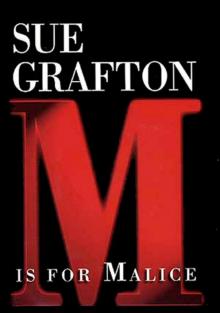 M Is for Malice
M Is for Malice I is for INNOCENT
I is for INNOCENT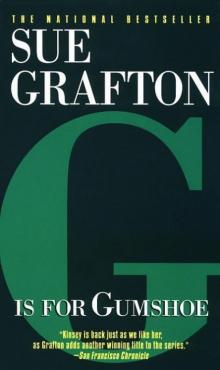 G is for GUMSHOE
G is for GUMSHOE K is for KILLER
K is for KILLER S is for SILENCE
S is for SILENCE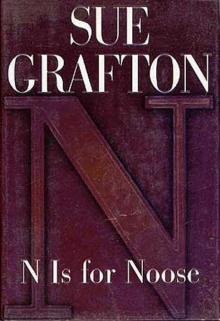 N is for NOOSE
N is for NOOSE D is for DEADBEAT
D is for DEADBEAT V is for Vengeance
V is for Vengeance U is for Undertow
U is for Undertow W Is for Wasted km-23
W Is for Wasted km-23 O is for OUTLAW
O is for OUTLAW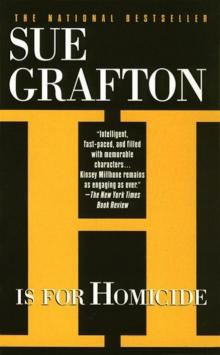 H is for HOMICIDE
H is for HOMICIDE Sue Grafton Novel Collection
Sue Grafton Novel Collection Kinsey and Me
Kinsey and Me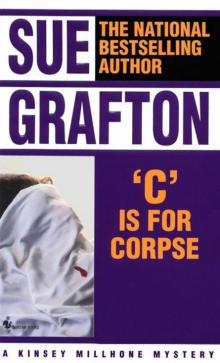 C is for CORPSE
C is for CORPSE F is for FUGITIVE
F is for FUGITIVE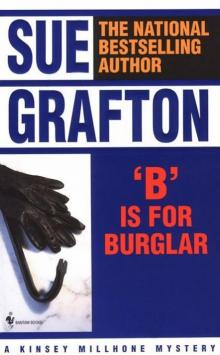 B is for BURGLAR
B is for BURGLAR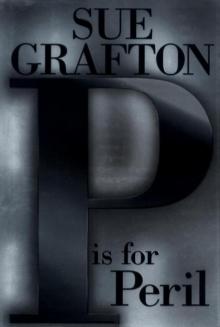 P is for PERIL
P is for PERIL A is for ALIBI
A is for ALIBI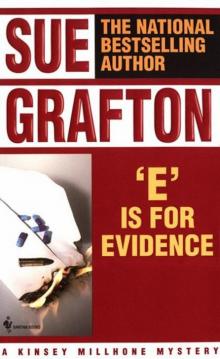 E is for EVIDENCE
E is for EVIDENCE J is for JUDGMENT
J is for JUDGMENT Q is for QUARRY
Q is for QUARRY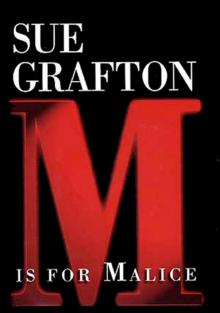 M is for MALICE
M is for MALICE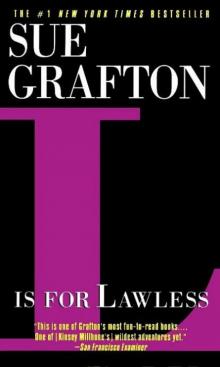 L is for LAWLESS
L is for LAWLESS